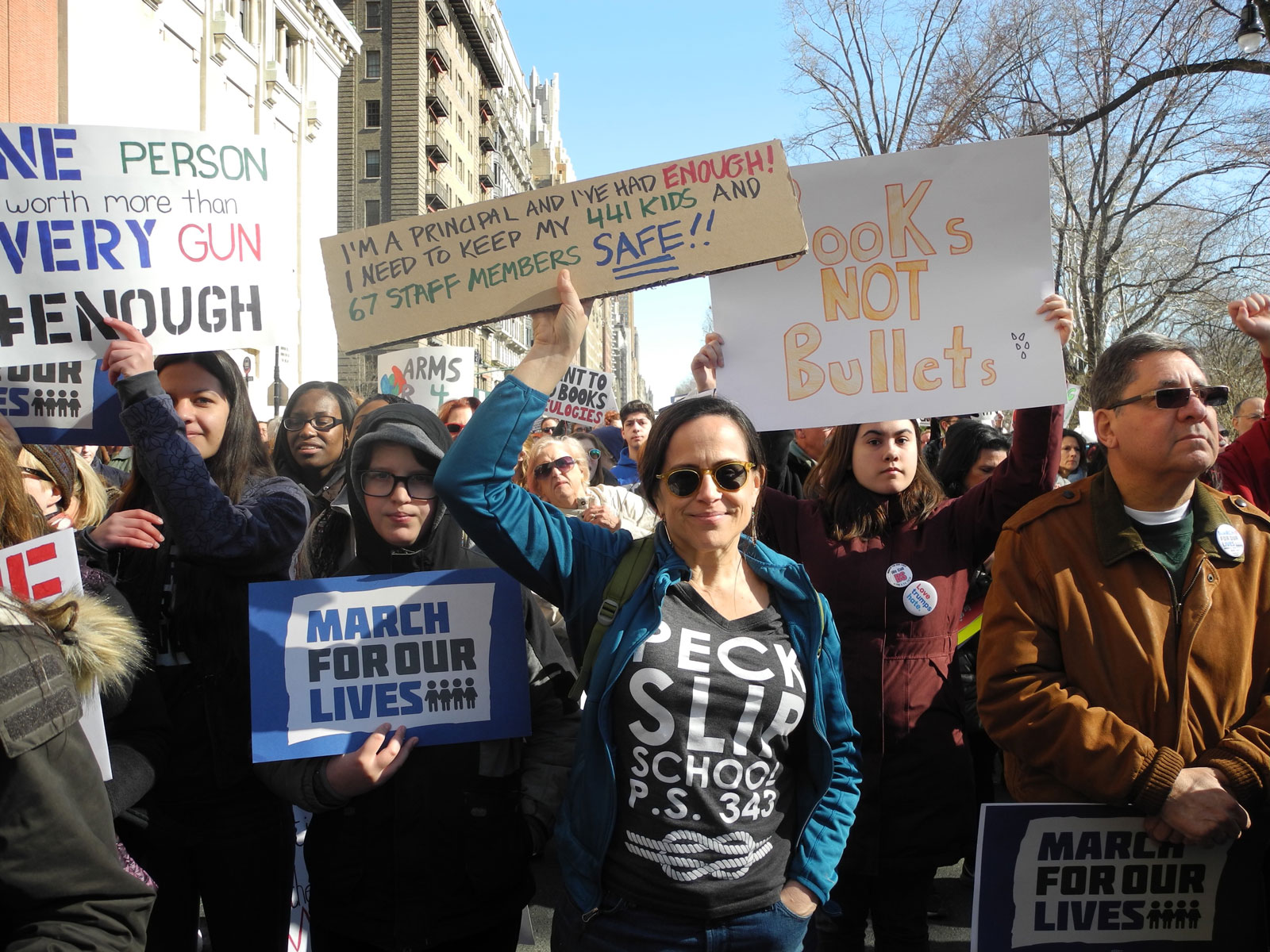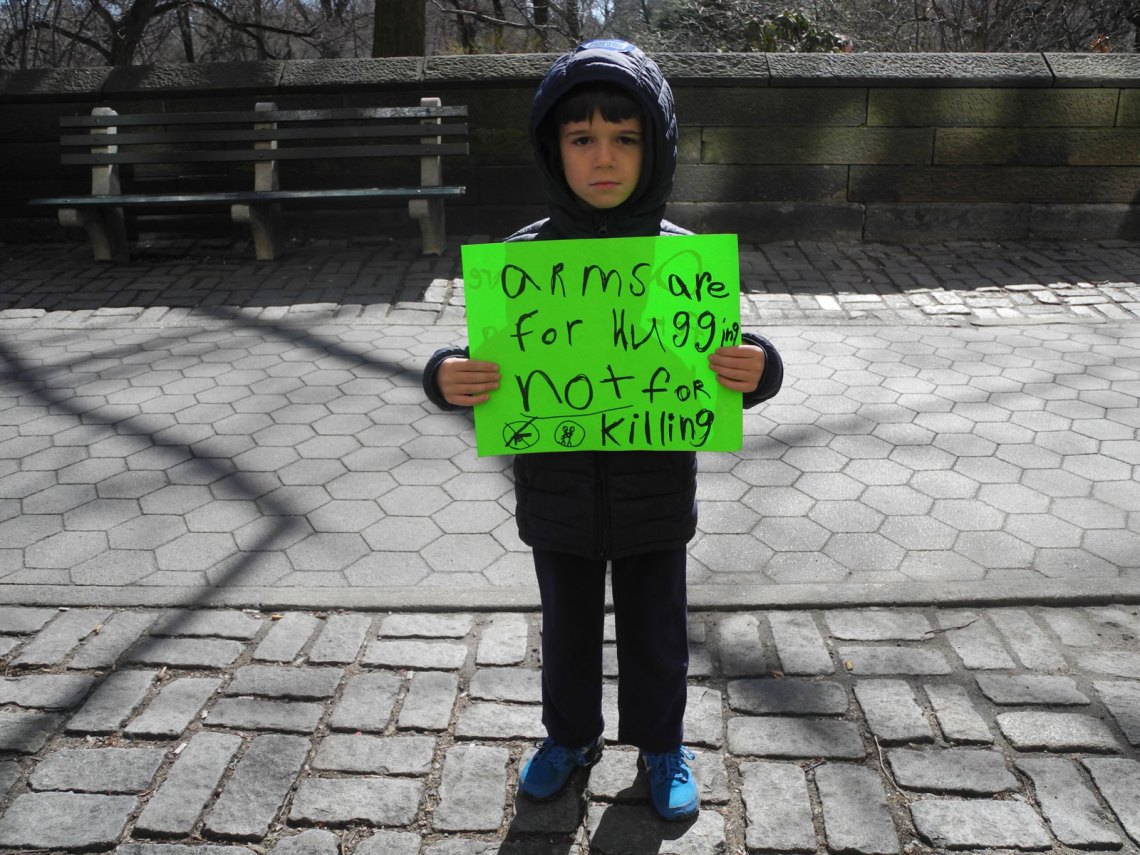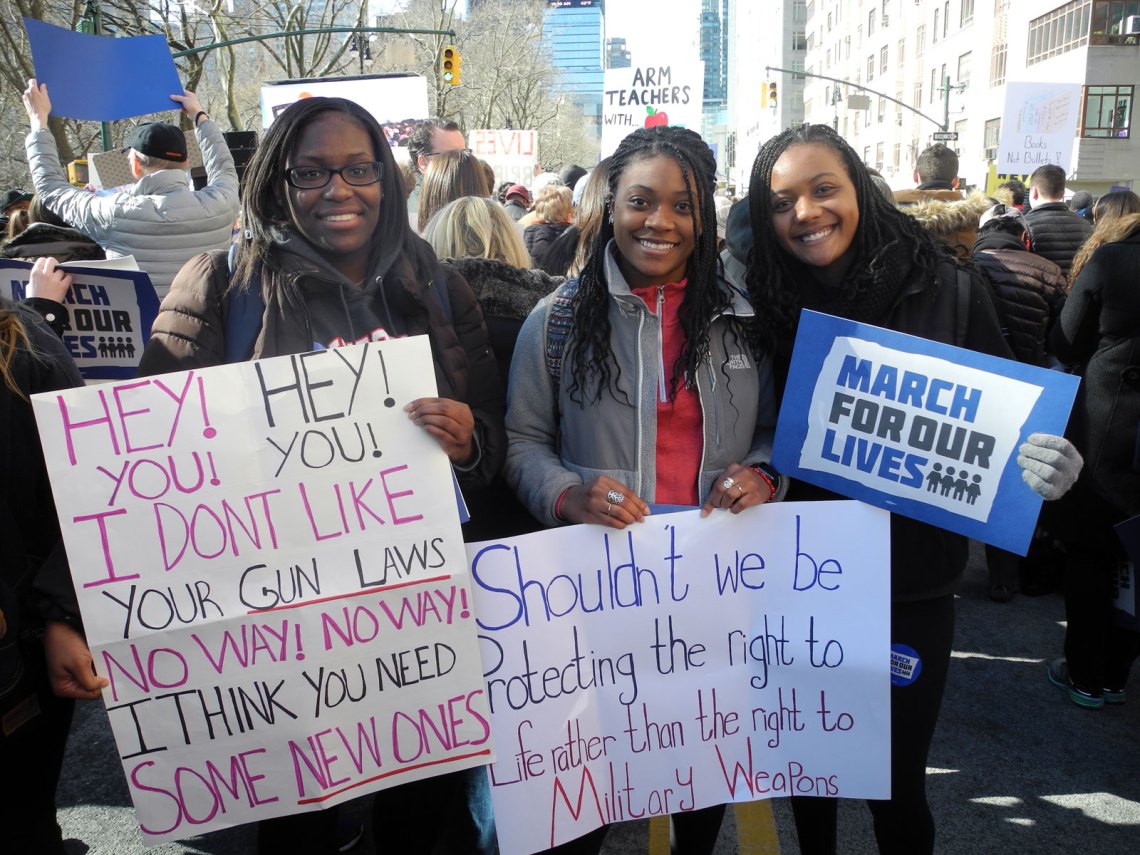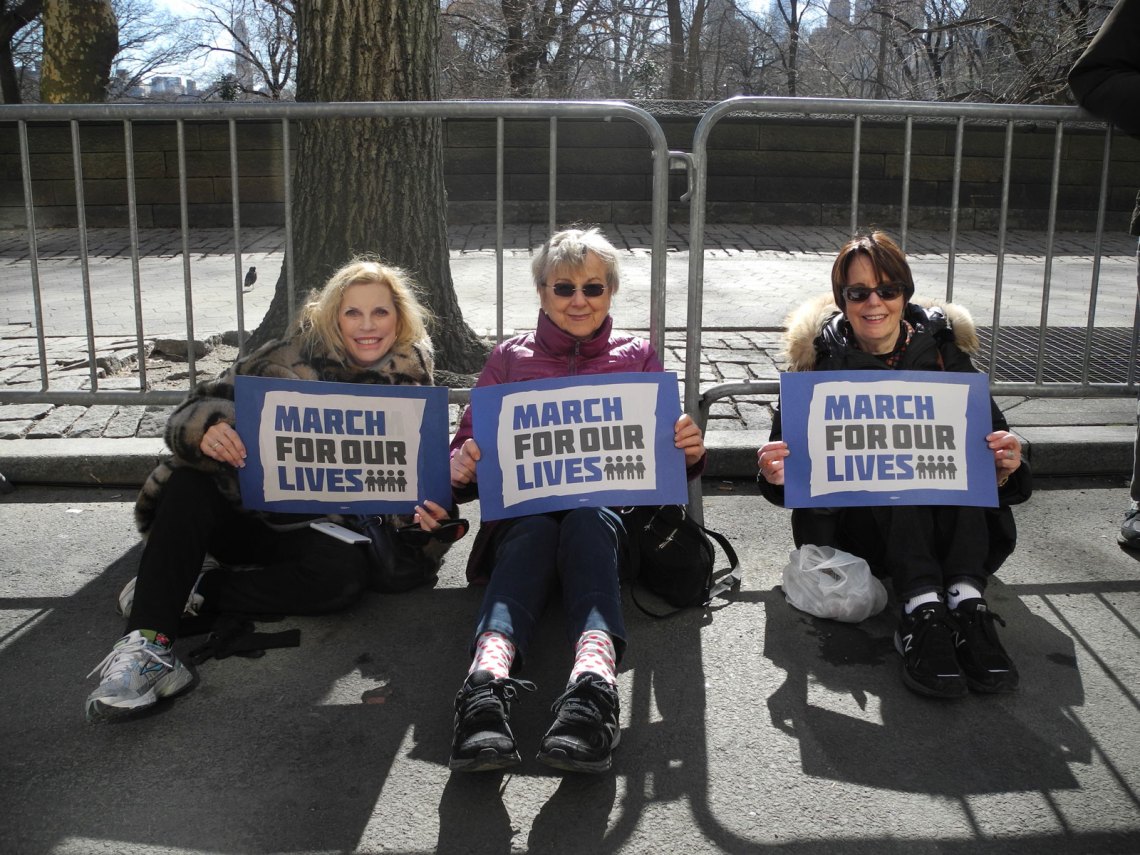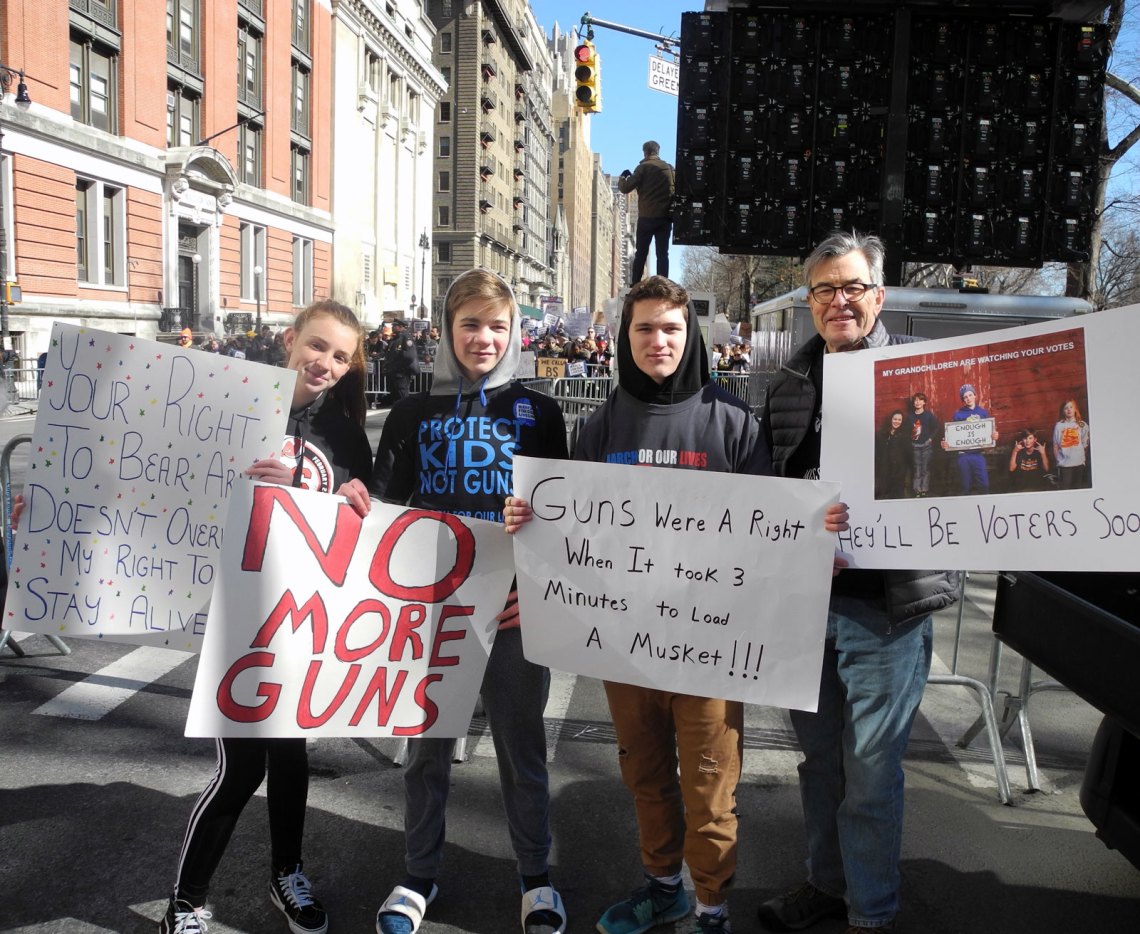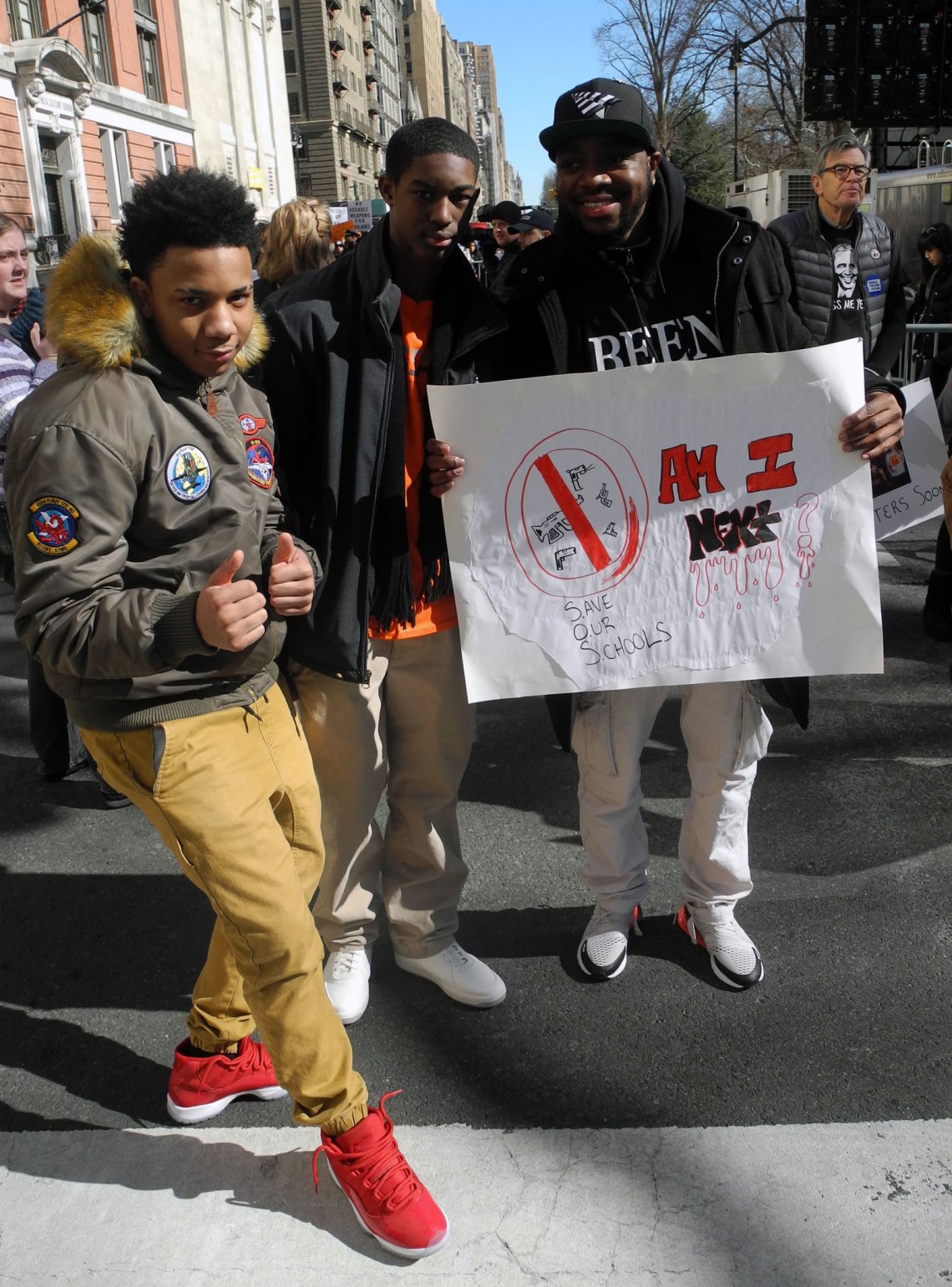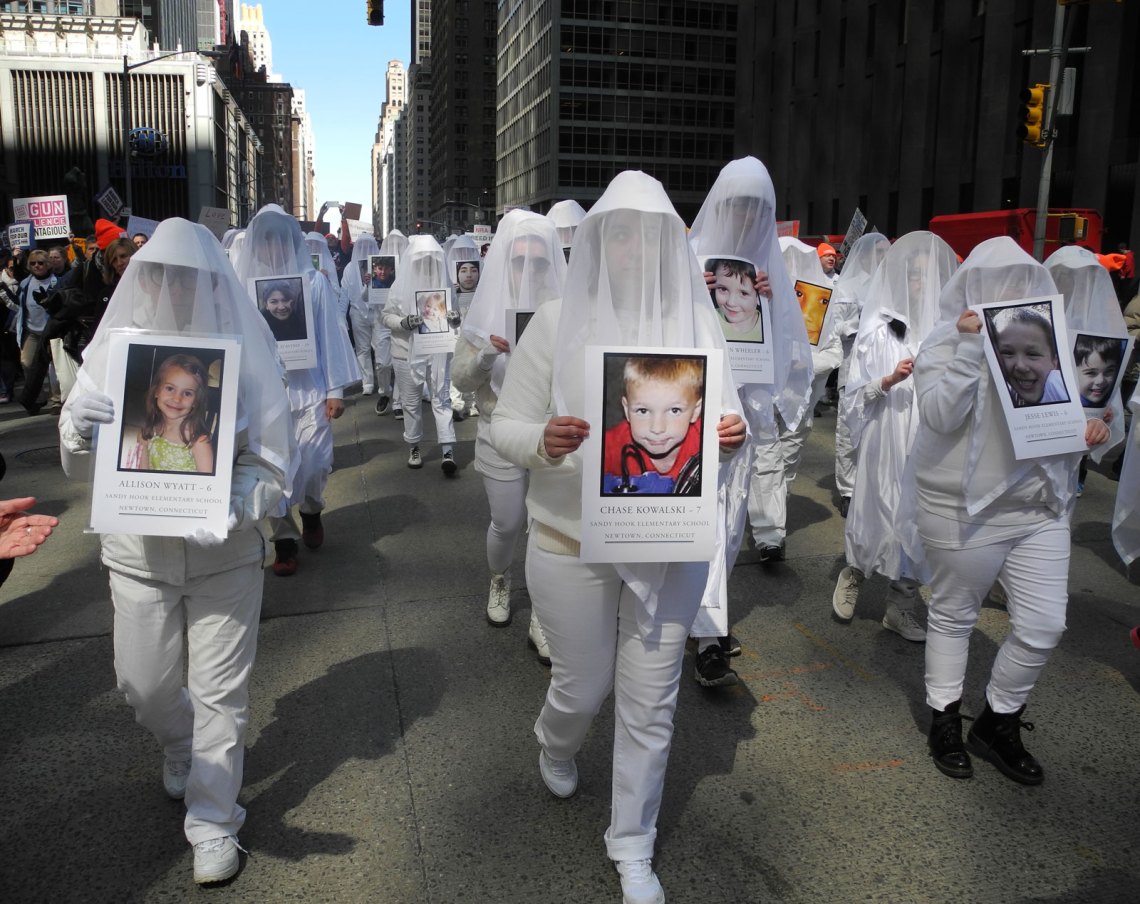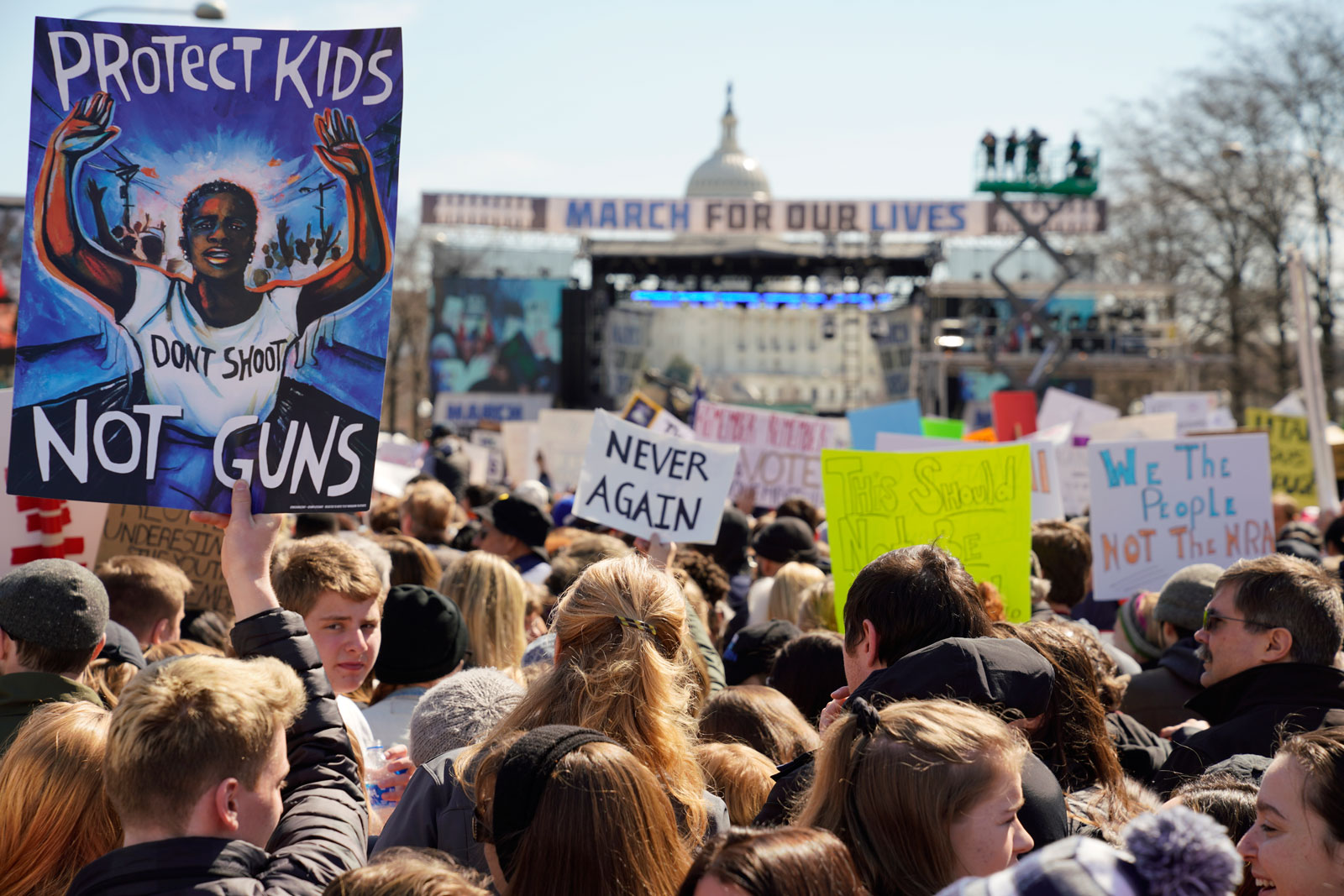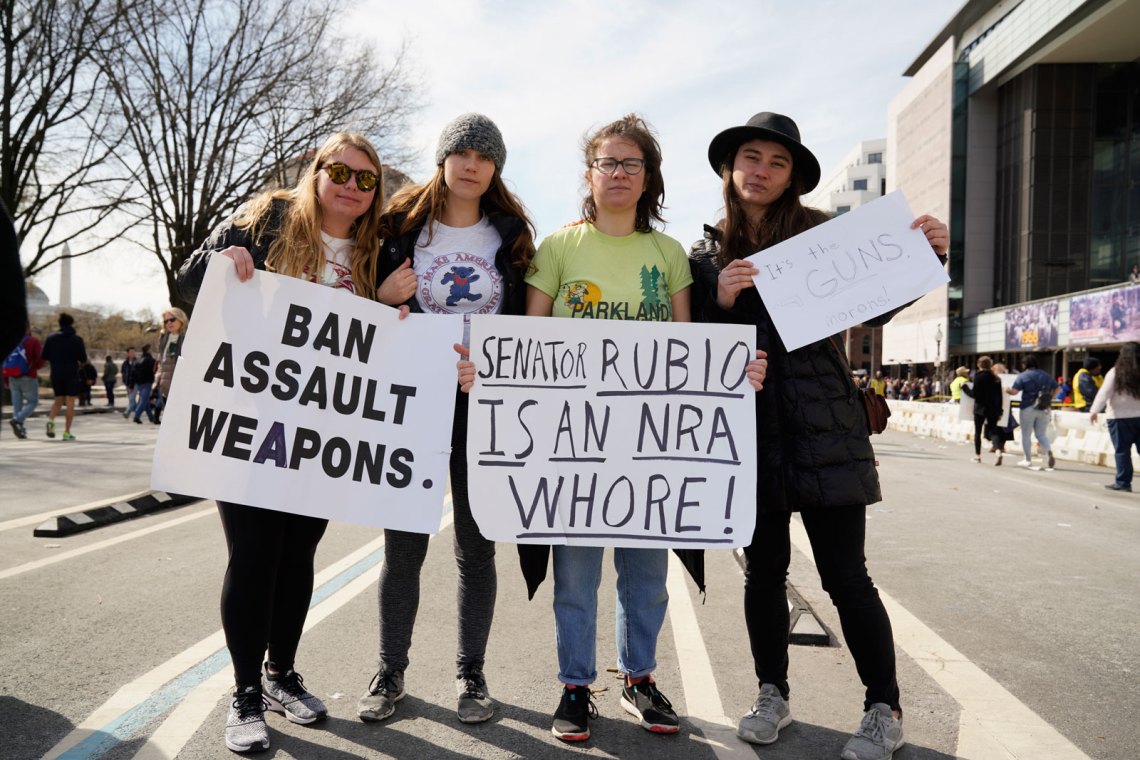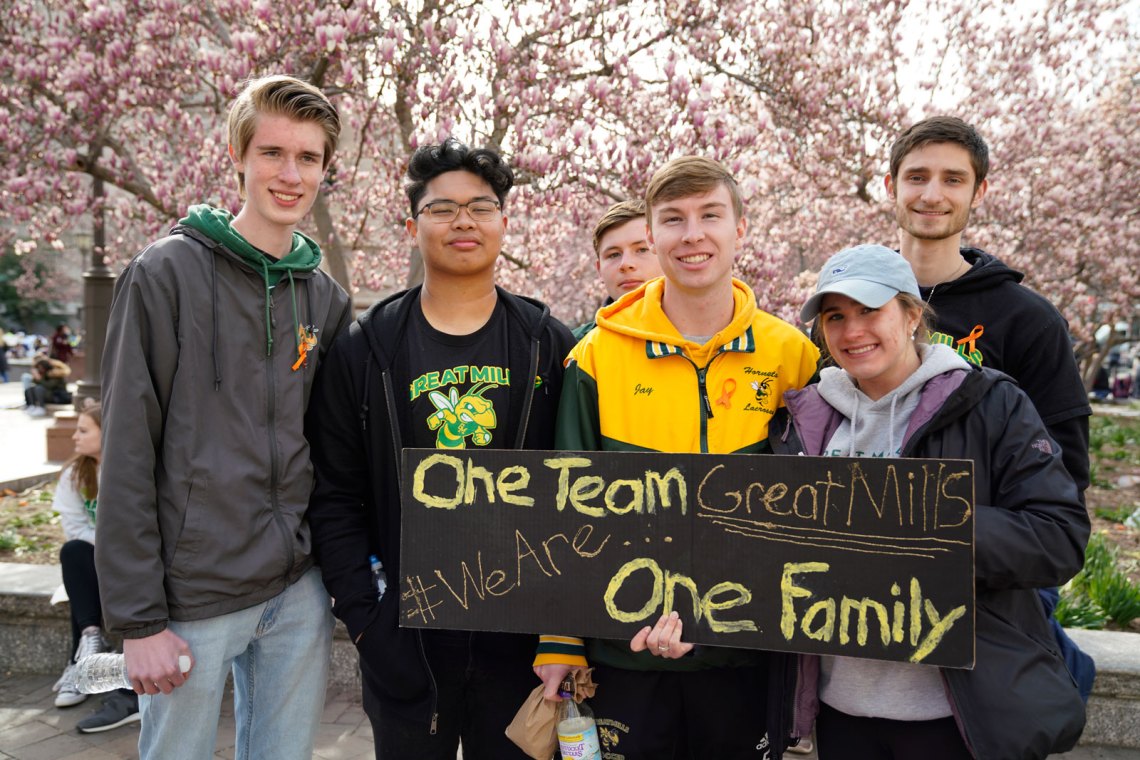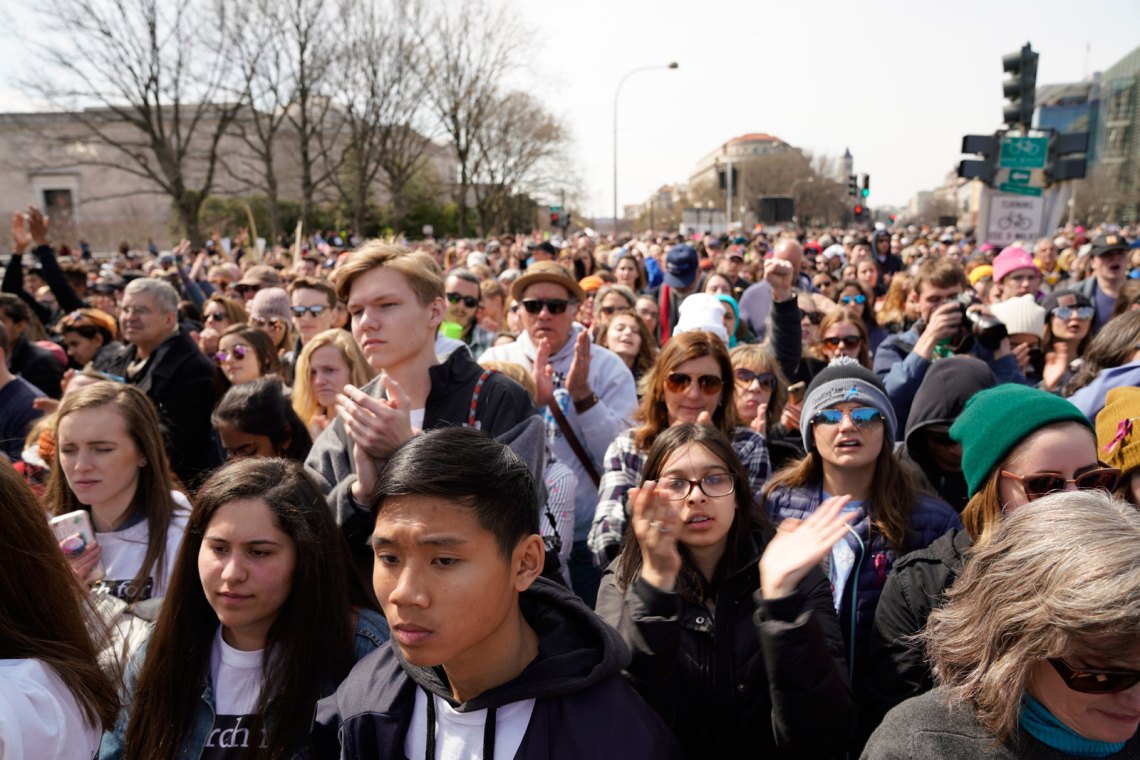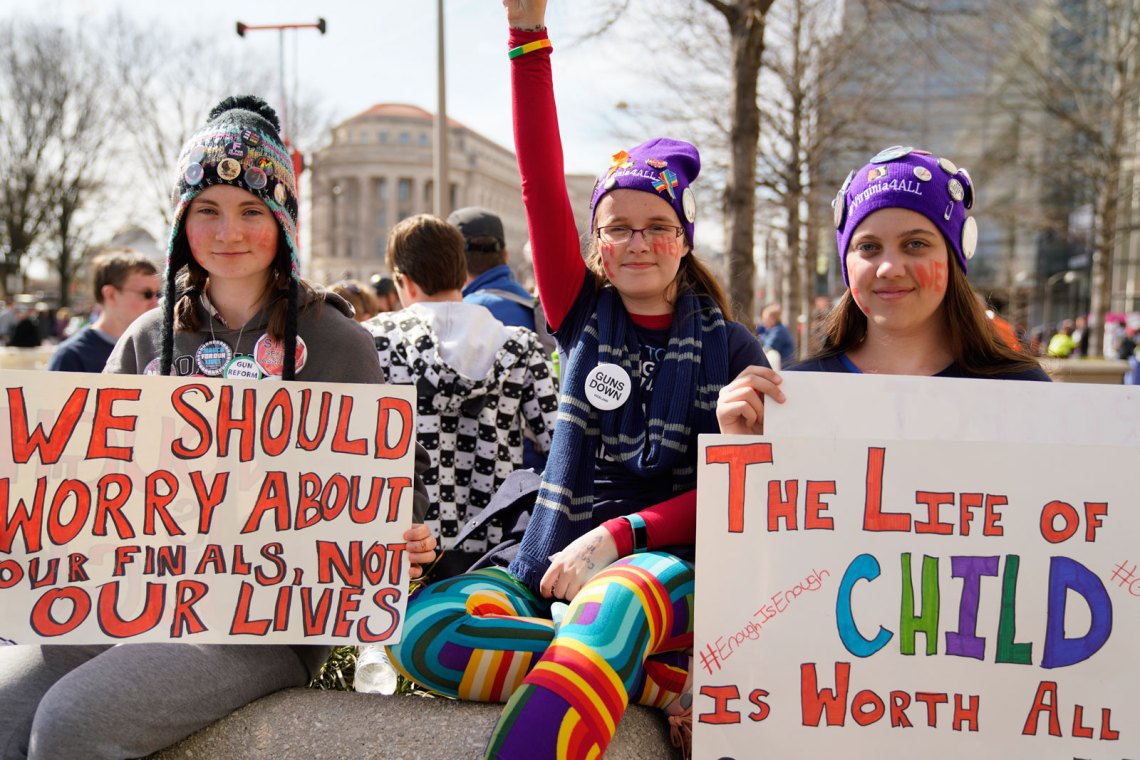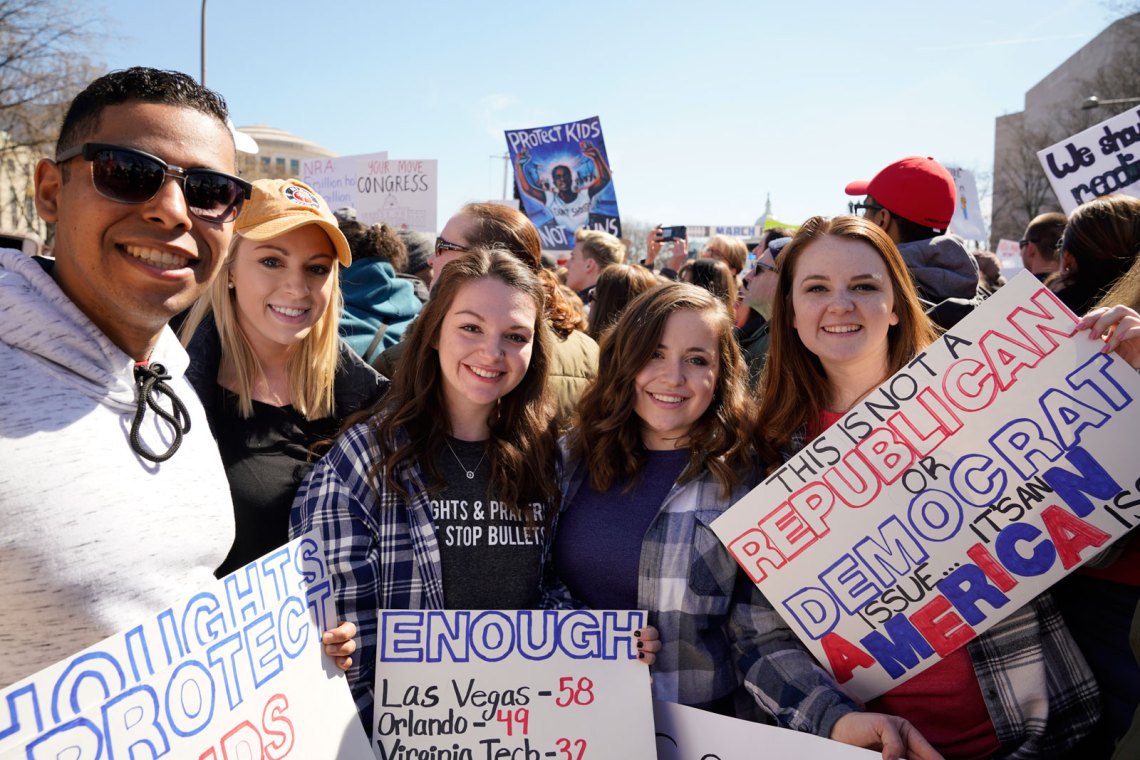I. New York City
“She hid under her desk. She didn’t know what was going on,” Heidi said of her twelve-year-old daughter Melinda, who stood at the March for Our Lives in New York City with Deanna, her nine-year-old sister, holding a sign that read, Enough is enough. Her phone had been in her book bag, so for twenty minutes she couldn’t contact anyone. While they waited as the school was on lockdown, a pregnant teacher rubbed her belly. It turned out to be a false alarm, but Melinda and her classmates were shaken. “This has become such a common occurrence,” Heidi told us, looking at her daughters. “It has to stop.”
Droves of people gathered at 72nd Street and Central Park West to walk south. Young people dressed in bright puffer jackets and pom pom hats were accompanied by older chaperones, some wearing buttons and stickers, and holding signs that conveyed simple messages of urgency: Protect kids, not guns, Books not bullets, and Arms are for hugging, not for killing (in the uneven crayon scrawl of a seven-year-old named Henry).
Many of the people we spoke to said they were driven to protest because they were tired of violence and grieving, and because they felt helpless. The crowd cheered affirmatively when asked if they were “sick and tired of being sick and tired,” and the lineup of speakers itself enacted the particular sort of emotional exhaustion that gun violence inflicts: a girl who had stayed calm while the Parkland shooter knocked on her classroom’s door; a woman who had lost two children; a college student who had lost her father; a boy who had been at the country music festival in Las Vegas, where his friend was shot in the back; a librarian at Sandy Hook who’d hidden a classroom of kindergarteners in a locked room; a woman whose grandchild was murdered at Stoneman Douglas; a girl who had lost her father on September 11. These stories take their toll. One sign warned: It will happen again… and again… and again… and again.
And yet these refrains of weariness were accompanied at every stage by energetic expressions of optimism, even joy, on the part of young people who were participating, organizing, and performing at the march. A group of Broadway Kids performed a ballad written by two Parkland students called “Shine,” with lyrics that could have been inspired by any number of high-school hardships—bullying, romantic rejection, failure: “You’re not gonna knock us down / We’ll get back up again / You may have hurt us but I promise we are stronger… You may have brought the dark / But together we will shine a light.” The song’s rallying cry highlights how easy it is to be on the right side of this issue. There’s one side that has “brought the dark,” and one that will “shine a light”—who are you with? In the words of Jackie, twelve: “I don’t like the fact that I could go to school and possibly get hurt.”
Simple to pick the right side, but not so simple to solve the problem. In their speeches on Saturday morning, the young organizers of the New York City march called for an intersectional approach to gun control: “Today we want to tell stories not just about what happens in our schools, but in those communities and neighborhoods who have faced these challenges for years. We recognize you. And we expect our media to recognize you as well.” The speakers who followed—diverse in age, race, region, and experience—demonstrated the point to a tearful audience. “You should care just as much about shootings in the Bronx and the south side of Chicago as you do about shootings everywhere else,” said Hawk Newsome, president of Black Lives Matter Greater New York. Hilda, a woman in her seventies attending the march with the Riverside Church, told us that anyone who perpetrates a mass shooting should be called a terrorist, no matter the color of his skin—whereas the media often uses words like “troubled” or “loner” to describe white male shooters, but “terrorist” and “extremist” to describe non-white shooters.
Advertisement
“We talk about mental health without really understanding what that means, how we address it, and how we create smart gun policy around it,” said a speaker who was in Las Vegas last fall when Stephen Paddock opened fire on a concert crowd, killing fifty-eight people and injuring 851 (422 of whom had gunshot wounds). The March for Our Lives is explicit in its support of gun control legislation like Florida’s Marjory Stoneman Douglas High School Public Safety Act—which raises the age to purchase a firearm from eighteen to twenty-one; requires a three-day waiting period for most gun purchases; and bans “bump stocks,” which allow semiautomatic rifles to fire like machine-guns. Mary Ann Jacob, the librarian at Sandy Hook, said she’d thought the deaths of twenty elementary school children would have been enough to motivate politicians to address our “uniquely American problem.”
“I originally come from a rural area so I grew up with guns,” said Narcissa, who came to the march with her husband and two middle-school-aged children. “But you shot coyotes with them or went hunting with them—they weren’t identities,” she told us. “They’ve become an identity, not a tool.” While some have charged the left, after the 2016 election, with blindly championing identity politics, it’s the right that is most tied to the gun lobby and has encouraged gun-owners to think and organize politically as an identity group.
Many young people—too young to vote—were marching at a demonstration for the first time in their lives, but for three older women sitting on the sidelines—Dale, Natalie, and Margo—this was one of countless such events they had attended throughout their lifetimes, including protests against the Vietnam and Iraq wars and for the Equal Rights Amendment. For Dale, the reason gun control was getting more attention than some of the other political issues she had supported in the past was that this was a matter of “life and death.” Then she reconsidered: “Well, with abortion, too, it was an issue because people had to get their abortions illegally… the same thing with Vietnam, no one wanted to die.”
The truth is, all political issues that mobilize us tend to be, at base, a matter of “life and death,” but they’re not always so easily expressed as such. One poster read, A child’s life is worth more than a gun, and then below, Do I even need to say that? Apparently, we do. Under an administration that so often makes us speechless with disbelief, we need the voices of people like Neil, aged fifteen, and a first-time marcher: “Everything’s totally unacceptable and it’s outrageous and it’s not okay.”
—Liza Batkin and Lucy McKeon
II. Washington, D.C.
Yesterday’s event on Pennsylvania Avenue should have been called Rally for Our Lives—it was by turns high school variety show, pop concert, and memorial tribute, but there was not much walking involved, except to stretch legs after standing in the street for four hours. At the D.C. Women’s March in 2017, the rally was effectively invisible and inaudible to most of the crowd, which was antsy to go somewhere and yell at somebody. The organizers of the March for Our Lives knew that what the people want now, above all, are the kids. We came to listen and to look them in the eyes.
While March for Our Lives was about gun violence, there were a few stray pussy hats in the crowd, and signs with slogans like “Guns have more rights than my vagina.” But unlike the everything-but-the-kitchen-sink politics of the Women’s March, the attendees at MFOL were resolutely on message. The only thing easier to buy than a gun in America is a Republican. Pack Lunch, Not Heat. Books not bullets. Art not artillery. Trump’s name was sparingly invoked: whenever anybody wanted to shame the government, they pointed angrily over their shoulders at the Capitol building, the stoic backdrop to the rally stage.
A group of high schoolers, stuck in the shade of a bedsheet spray-painted with TRUMP IS AFRAID OF THE NRA, formed a human pyramid in an attempt to see the stage. The woman next to me had brought her middle-school children, George and Ava, from Denver. “Do you think Emma Gonzáles is going to speak?” she asked them with the trepidation of a mom. “I wonder if she’s nervous. Imagine speaking in front of 500,000 people.”
“Let’s get this bitch started,” said an impatient girl with a nose ring.
From gigantic video screens and booming speakers funded by liberal donors such as Oprah and the Clooneys, the voices on stage reached everyone on Pennsylvania Avenue. The Parkland students were joined by student activists from across the country, all of whom had either lost a sibling, classmate, or friend to gun violence, or stared down the barrel of a gun themselves. Their stories were harrowing, their metaphors fresh, and all are worth watching. But in the spirit of yearbook superlatives, here are some highlights. Best Comeback: Samantha Fuentes, vomiting onstage in the middle of her poem. (Nose ring:“That’s gotta suck.”) The cameras panned politely away, onto the anxious crowd. We needn’t have worried. “I JUST THREW UP ON INTERNATIONAL TELEVISION,” screamed Samantha, “AND IT FEELS GREAT!” Best Throwback: Alex Wind, who reminded us, “When Joan of Arc fought back English forces, she was seventeen years old!” Best Reveal: Martin Luther King Jr.’s granddaughter Yolanda King, brought out to lead a call and response.
Advertisement
The astonishingly poised eleven-year-old Naomi Wadler paid tribute to “the African American women who are victims of gun violence, who are simply statistics, instead of vibrant, beautiful girls full of potential.” Christopher Underwood, also eleven, reminded everyone that MLK was killed by a gunman. Edna Chavez from South Los Angeles greeted the crowd in Spanish, and made thousands weep with her speech honoring her late brother Ricardo and her community.
After two hours of tears and sunburn, the crowd was starting to wilt. “Where’s Emma?” people muttered. When Emma González finally took the stage, it was to deafening cheers; her no-bullshit anger seems to have sanctified her, and like Malala Yousafzai, who gave the march her blessing over video, González inspires a special kind of awe. So when she engaged the masses in a six-minute staring contest, everyone fell dead silent and stared back. Even the guy shouting “VOTE THEM OUT!” was hushed.
By the time Jennifer Hudson, who lost her mother, a brother, and a nephew to gun violence, finished “The Times They Are A’ Changin,” it became clear that nobody would be expected to march anywhere. A disembodied voice declared the event over and asked the crowds to disperse. Thousands milled. Cell service returned; separated friends found each other. Three women danced for a circle of cameras. A lanky man with fake blood dripping down his face and clothes posed for photos, directing press to his Instagram.
A group of women walked by with a gutsy sign: “SENATOR RUBIO IS AN NRA WHORE.” They were Stoneman Douglas alums, class of ’11. They were too old to know the Parkland organizers, but had come from Boston and Chicago to be at the rally. They told me about their hometown, a place I’d once stumbled through during a spring break trip and remembered as a landscape of canals and golf greens.
“It’s a good school,” Nicole Rudd said of Stoneman Douglas. “People move there for the schools, property taxes are outrageous.” Veronica Little was blunter: “Parkland is a rich-ass town… They’re privileged kids, who come from really supportive families—powerful families—with connections, who can make a March for Our Lives, overnight.” They were glad that the Parkland students had called out that privilege on stage, and used it to elevate the voices of activists from Chicago and South LA.
Three young friends, armored in plastic buttons, chatted on the curb. They were D.C. locals; I asked if protesting had become a hobby for them. Laughter and a chorus of Oh, yeah. They showed me their F is for Feminist, Black Lives Matter, and FUCK TRUMP badges. “I’m the pin goddess,” confessed Maya, fourteen.
The young people in attendance, conspicuously, were mostly girls. So when I saw a band of guys in green-and-gold lacrosse jackets, I made a beeline for them. I didn’t recognize the colors of Great Mills High, the school an hour and a half south of D.C. where a student shot sixteen-year-old Jaelynn Willey on Tuesday, just six days after the school’s walkout in solidarity with Parkland. She died in a hospital on Thursday. The boys were somber and perhaps a bit dazed, but spoke about how their school and community had come together after the shooting. They estimated over three hundred people from Great Mills were in D.C. “I’m proud of our community for coming out here and being able to show our support,” said Richard Britos. “Coming here is a big deal for us to, you know, heal,” said Jonathan Feid.
Volunteers with clipboards harassed every marcher: “Are you registered to vote in the state where you live?” The digits 227, the number of days until the midterm elections, were plastered on hats and telephone poles. The day’s mantra, chanted between speeches, gathering in waves down the avenue and ricochetting off the dome of the Capitol, was short and to the point: Vote them out. Vote them out. It was loud enough that they must have heard.
—Lucy Jakub


